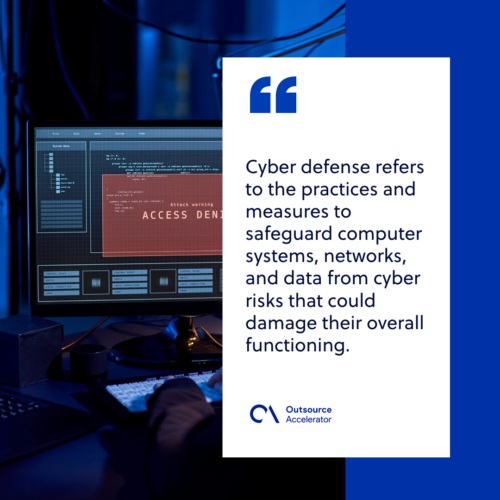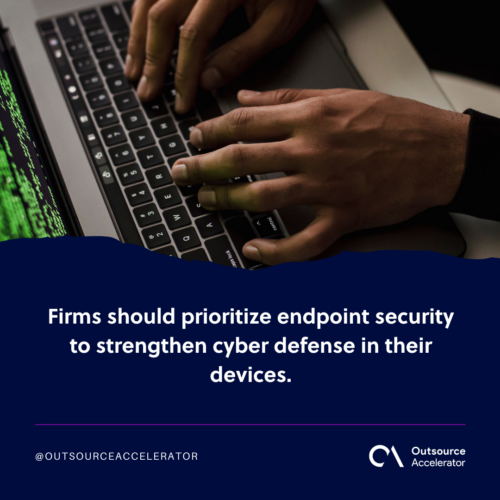6 effective ways to build a strong cyber defense security

Cyber threats, ranging from malware attacks to sophisticated hacking attempts, continue to grow and present significant digital threats. Protecting sensitive information and maintaining vigorous digital security has become a top priority for organizations.
Building a robust cyber defense environment is critical for protecting digital borders and assuring data confidentiality, integrity, and availability.
In this blog post, we’ll cover the most prevalent cyber threats and six effective approaches to building robust cyber defense strategies.
What does cyber defense mean?
Cyber defense refers to the practices and measures to safeguard computer systems, networks, and data from cyber risks that could damage their overall functioning.
It includes using protective strategies, advanced technologies, and standard methods to protect digital assets proactively.
The main goal of cybersecurity is to prevent and reduce the risks that cyber attacks like malware, phishing, denial of service attacks, and SQL injections bring.
Businesses and organizations can ensure that their information systems and private data are safe, secure, and available by taking strong security measures.
Firms must set up constant monitoring, risk assessment, cyber security practices, and employee training for a more effective cyber defense.

4 most common cyber threats
The digital landscape is rampant with various cyber threats that can pose significant risks to individuals and organizations. Understanding the most common cyber threats is essential in developing effective cyber defense strategies.
Here are four of the most prevalent cyber threats:
Malware
Malware, short for “malicious software,” is a file or code designed to infiltrate computer systems, disrupt operations, and compromise sensitive data.
These threats take the form of infected email attachments, malicious websites, or compromised software.
Common types of malware include the following:
- Viruses
- Worms
- Ransomware
- Spyware
Phishing
Phishing attacks involve tricking individuals into revealing sensitive information, such as login credentials or financial details, by masquerading as trustworthy entities.
Cybercriminals typically use deceptive emails, text messages, or fake websites to lure unsuspecting victims into providing confidential data.
Denial of Service (DoS) attacks
DoS attacks overwhelm a target system, network, or website with an overwhelming traffic volume, rendering it inaccessible to legitimate users.
By flooding the target with requests, attackers can disrupt services, cause downtime, and hinder normal business operations.
SQL injection
SQL injection is an attack technique where malicious actors exploit vulnerabilities in a web application’s database layer.
By injecting malicious SQL statements into user input fields, hackers can manipulate the database and gain unauthorized access to sensitive data or perform unauthorized actions.
6 ways to build a strong cyber defense security
Now that you know the different types of cyber security threats, here are the six effective ways to combat malicious attacks.
1. Identify vulnerabilities via risk assessment
Conduct a thorough risk assessment that examines the organization’s IT infrastructure, procedures, and assets. This is crucial for discovering vulnerabilities and gaps in your company’s defense structure.
A risk assessment assists companies in understanding their vulnerability to risks and the possible consequences of such threats.
Organizations may stay proactive and efficiently handle new dangers by performing frequent evaluations. This technique helps them to select efficient security measures based on recognized threats.
2. Implement proactive security measures
Building a solid cyber defense requires proactive security measures. Organizations may anticipate and reduce possible hazards by adopting proactive measures.
Consider the following proactive security measures:
Network security
Network security is a fundamental component of cyber defense. This includes deploying firewalls to monitor and control incoming and outgoing network traffic.
It also has intrusion detection and prevention systems (IDPS) that identify and respond to potential threats.
Endpoint security
Cybercriminals often target endpoint systems like computers, laptops, and mobile devices. Firms should prioritize endpoint security to strengthen cyber defense in their devices.
This involves implementing antivirus software to detect and remove malware and encrypting sensitive data to prevent unauthorized access.
Further, endpoint security measures provide additional protection and help mitigate the risks associated with device vulnerabilities.
Data security
Companies should put strong data security means in place to secure their data. Encryption is key to data security because it rearranges data so unauthorized people cannot read it.
Access controls, like strong authentication and ownership based on roles, are the main features of a data security system.

3. Conduct employee training and awareness programs
Human errors and negligence are still major contributors to cyber attacks. Organizations should engage in comprehensive personnel training and awareness initiatives to establish a robust cyber defense strategy.
These programs educate employees on cybersecurity best practices, making them aware of possible threats and their responsibility in ensuring a safe workplace.
4. Utilize AI for threat detection
Incorporate AI into your cyber defense strategies to proactively detect and respond to threats, enabling a more robust and efficient defense against cyber attacks.
However, it is important to note that AI is not a standalone solution, and human expertise is still vital in interpreting AI-generated insights and making critical decisions.
Combining human intelligence and AI-powered technologies can significantly strengthen an organization’s cyber defense posture.
5. Develop incident response plans and procedures
You must adopt well-defined incident response plans and processes to guarantee a disciplined and coordinated cyber defense approach to security breaches.
The roles and duties of each company personnel should be clearly defined to allow a successful incident response.
6. Stay updated on emerging cybersecurity trends
Businesses should actively participate in industry forums, subscribe to reliable cybersecurity publications, and participate in training programs to keep up with the changing threat landscape.
Safeguard your digital frontiers with a proactive cyber defense
Organizations may strengthen their resilience against cyber threats and safeguard their priceless data and systems using the six practical cyber security solutions discussed above.
Remember that the best way to protect our digital environment and keep one step ahead of threat actors is to take a proactive, multi-layered strategy to cyber defense systems.







 Independent
Independent




